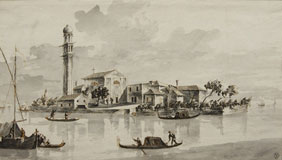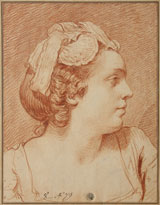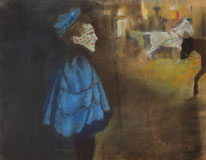Collection / European
Graphics
European drawing has a more than 600 year-old history and through the course of time it has undergone considerable changes. Unfortunately, the modest collection of the Western European drawings, consisting of more than 160 items by somewhat obscure painters, some works of unknown artists, and an album of 92 sketches by the German painter Friedrich Frisch (1813-1886) hardly represents the entire picture of the development of drawing of that period. Nevertheless the collection includes some interesting works both from artistic and scholarly aspects. In regards to the quality and quantity, all the drawings of the Italian, Dutch, Flemish, and French schools should be mentioned first. English, German, Belgian, Swiss, Austrian, and Romanian painters are represented by one or a few works.

It is a well-known fact that in the period of the Renaissance drawing fully manifested itself in the variety of forms and became a separate and specific branch of art. The characteristic feature of the Italian Renaissance are reflected in the works of the Veronese painter Paolo Farinati (1524-1626). His cartoon of the frieze “The Battle between Alexander the Great and Darius” is the pride of our collection. In the same period the Venetian painter Ludovico Pozzoserrato (ca. 1550-1603/5) decorated interiors and pediments of buildings. The magnificent “Plan of a Fresco” is ascribed to him; it is one of the rare extant works of the master. The Italian collection also includes drawings by Luca Cambiaso (1527-1585), Pietro Dandini (1646-1712), Jacopo Vignali (1592-1664), Bernardo Bellotto (1721-1780), Giovanni Domenico Tiepolo (1727-1804) and others.
The characteristic feature of the Italian Renaissance are reflected in the works of the Veronese painter Paolo Farinati (1524-1626). His cartoon of the frieze “The Battle between Alexander the Great and Darius” is the pride of our collection. In the same period the Venetian painter Ludovico Pozzoserrato (ca. 1550-1603/5) decorated interiors and pediments of buildings. The magnificent “Plan of a Fresco” is ascribed to him; it is one of the rare extant works of the master. The Italian collection also includes drawings by Luca Cambiaso (1527-1585), Pietro Dandini (1646-1712), Jacopo Vignali (1592-1664), Bernardo Bellotto (1721-1780), Giovanni Domenico Tiepolo (1727-1804) and others.

In the seventeenth century Dutch and Flemish painting flourished. Among the Dutch drawings worth mentioning are the works by Jan van Goyen (1596-1656), the sketch composition “Two Sitting Women” by an artist from Rembrandt’s school, and Willem de Heer’s “Dining Peasants”. His drawings on parchment are very rare in thecollection of museums.
The Flemish drawing of the seventeenth century is represented by the sketches “A Peasant’s Head” ascribed without certainty to “the most Flemish painter” Jacob Jordaens (1539-1678), the expressive “Dog’s Head” of the animalist and master of still life Jan Fyt (1611-1661), and Bonaventura Peeters’ (1614-1652) “Marine Battle”.
The French school is represented by a series of marvelous drawings of the seventeenth-twentieth centuries.These works include the valuable drawing “A Standing Boy” by mannerist Jacques Bellange (ca. 1575-1616), the sanguine sketches by Edme Bouchardon (1698-1762), Jean
 Baptiste Greuze (1725-1805), and Hubert Robert (1733-1803), “The Woman in Blue” by Louis Anquetin (1861-1932), and the “Street Scene” by Jules Pascin (1885-1930).
Baptiste Greuze (1725-1805), and Hubert Robert (1733-1803), “The Woman in Blue” by Louis Anquetin (1861-1932), and the “Street Scene” by Jules Pascin (1885-1930).
The Museum possesses graphic sheets by the famous German graphic artist Jurgen Ovens (1623-1678), Daniel Chodowiecki (1723-1801), and Franz von Stuck (1863-1929), as well as landscapes by the Swiss painter William J. Ferguson (nineteenth century), and the Belgian painter Leon Frederic (1856-1940).